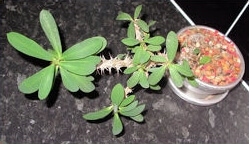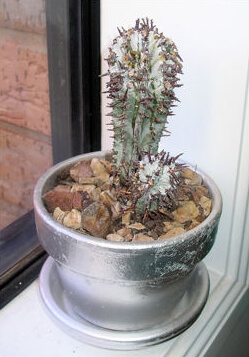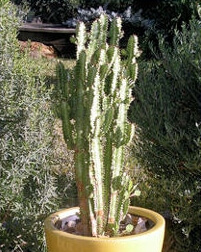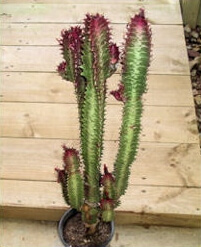Euphorbia is a very variable genus of plants consisting of thousands of species. They vary in so many ways that one gardener's idea of a Euphorbia may be completely different to another’s.
The euphorbias I’ve taken an interest in are the ones that have a similar appearance to cacti and in some cases have even been mistaken as being cacti just because they have spines.
More...
Types of Euphorbia to Grow in Australia
In some respects these types of Euphorbia are still a bit of a novelty plant here in Australia, especially here in Melbourne. The reason I say this is, one, you rarely see them growing in gardens and two, when you see them in plant nurseries they are often sold as novelty plants without correct labels or growing instructions.
Quite often they are also given novelty type names and sold as plants to be grown indoors in small pots.
Euphorbia milii (Crown of Thorns)
I remember when I bought my first Euphorbia about 5 years ago. I came across it in a garden centre looking very neglected, without a label and in a pot that had been dropped at some stage. You could see where the potting mix had been scraped off the ground and put back into the pot again.
Now I’d probably be lying to you if I said I felt sorry for it as I can remember it was really the plant itself that fascinated me. It had a long narrow stem and branches that were covered in thorns with small green leaves.
Despite having no idea what it was I decided to take it home, Google it and find out what it was. It turned out to be a type of Euphorbia milii and what a tough little plant it has proven to be.

I’ve been growing it indoors in this pot for the last 5 years . When I first planted it, it was a bit of a lean as I thought this added to the Bonsai look but as you can see it is nearly growing horizontally from the side of its pot now.
This little euphorbia really does thrive on neglect as it rarely gets watered and may only have been fertilised 2 or 3 times since I’ve had it. I think it’s now probably long overdue for some maintenance, so I think I’ll repot it, straighten it up and give it some fertiliser and Seasol.
Euphorbia polygona (African Milk Barrel)

Euphorbia polygona is another one I’ve been growing indoors as well for about the same amount of time. When I bought this one it was just a single plant, but now as you can see there is a second one growing.
These euphorbias really do make great indoor plants and because they grow so slowly you can just buy the size you’re after and then it will survive quite happily with a minimum of attention. The worst thing you can probably do is water it too much during cold weather.
Another great thing about euphorbias is that not only will they grow quite happily indoors but they also grow quite well outdoors in pots. Because they are very drought tolerant plants, you don’t have to continually water them over summer, while in winter you can shift the ones that don’t like frost or cold weather under shelter. Euphorbias really are great plants for pots.
Euphorbia trigona (African Milk Tree)


One of my favourites is Euphorbia trigona. The one below in the yellow pot was given to me by my sister and has survived 2 summers in this pot with a minimum of water and attention.
The red one on the right also survived in a similar position although in spring when the weather starts to warm up I am going to plant it in the ground as I’d like to maximise it’s growth and turn it into a feature in my front garden. I really like the red tips.
The one thing about Euphorbia trigona is that it doesn’t like frost or too much water when it is cold. Therefore here in Melbourne I will have to be careful where I plant it.
The best place will be in a raised bed so the excess water drains away and despite not getting very much frost in Melbourne it will also be best to plant it in a protected area just in case. Another thing to remember about Euphorbia trigona is that the green one appears to be more cold tolerant than the one with the red tips.
The garden centre not far from where I live has one of each growing in its garden. The garden bed is not raised off the ground and the red Euphorbia trigona looks very sad indeed. Just like a succulent that is sitting in too much water. The green one on the other hand though looks to be doing ok.

Euphorbia ingens ‘Variegata Ammak’
Euphorbia ingens ‘Variegata Ammak’ is another Euphorbia that I’m going to add to my garden in the spring. This euphorbia will branch into a bush and grow quite large but it also doesn’t like frost so I will probably plant it up against a north facing brick wall to keep it warm in the winter.
This is another euphorbia that will grow into a bush. Just like Euphorbia ingens, I’m waiting for spring before I plant this one in my garden.
Euphorbia Offers an Array of Striking Forms and Colors to Enrich any Landscape
So there you have it, there are thousands of varieties of euphorbias. The ones that grow into a cactus-like shape are the ones that I really like but if you have a look around, their shapes and sizes are so wide and varied, there’s probably one for every taste.
I’ll write about these particular euphorbias again after they get planted and I’ll also have a go at propagating a few as well.
Just one other thing that is important to mention about euphorbias. If you are going to propagate them from cuttings or just prune them they do have a milky sap inside them that can be poisonous, so it does pay to take special care to avoid getting the sap on you.
So if you live in a cold area plant them in a raised bed with good drainage and try and protect them from the frost. Or if you like you can just grow them in a pot, either indoors or outside. As far as my euphorbias above go, I’ll plant them in the ground, but that will have to wait until spring.
Published on October 5, 2023 by Gary Clarke
Last Updated on February 14, 2024




